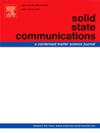电沉积Ni1-xFex纳米线的磁化反转动力学
IF 2.1
4区 物理与天体物理
Q3 PHYSICS, CONDENSED MATTER
引用次数: 0
摘要
本文报道了富镍镍- xfex电沉积纳米线的磁化反转动力学。采用脉冲电化学沉积的方法,通过多孔的轨迹蚀刻聚碳酸酯模板,合成了具有不同Ni和Fe成分(百分比)的有序排列的Ni1-xFex纳米线。利用扫描电子显微镜(SEM)研究了纳米线的形状和尺寸。x射线衍射(XRD)分析表明,纳米线具有多晶性质,平均晶粒尺寸为~ 6.9 nm。利用透射电镜(TEM)对材料进行结构表征,确定材料的结构性质,并用能量色散x射线分析(EDX)对其化学成分进行分析。利用原子力显微镜(AFM)和磁力显微镜(MFM)研究了这些纳米线的形貌和磁畴结构。采用振动样品磁强计(VSM)技术测量了嵌入模板中不同成分的Ni1-xFex纳米线的磁滞回线。在平行于纳米线轴线和垂直于纳米线轴线的外加磁场下测量的磁滞回线在形状和矫顽力场上有明显的差异,这说明了织构和铁含量对样品的影响。通过微磁模拟(OOMMF)来理解实验结果,并与磁性纳米线的磁化反转机制建立关联。本文章由计算机程序翻译,如有差异,请以英文原文为准。
Magnetization reversal dynamics of electrodeposited Ni1-xFex nanowires
We report on the magnetization reversal dynamics of Ni-rich Ni1-xFex electrodeposited nanowires. Ordered arrays of Ni1-xFex nanowires with varying Ni and Fe composition (in percentage) are synthesized using the pulsed electrochemical deposition method through porous track-etched polycarbonate templates. The shape and size of the nanowires are investigated by Scanning Electron Microscopy (SEM). X-ray diffraction (XRD) analysis shows the polycrystalline nature of the nanowires, having an average crystallite size of ∼6.9 nm. Structural characterization is carried out to establish the material and structural property by TEM, while the chemical composition is analyzed with Energy Dispersive X-ray analysis (EDX). Atomic Force Microscopy (AFM) and Magnetic Force Microscopy (MFM) are employed to investigate the topography and magnetic domain structures of these nanowires. The vibrating sample magnetometer (VSM) technique has been carried out to measure the magnetic hysteresis loops for the Ni1-xFex nanowires with different compositions embedded in the template. The hysteresis loops measured with an external magnetic field applied parallel and perpendicular to the axis of the nanowires show a clear difference in the shape and the coercive field, indicating the effect of texture and iron content in these samples. Micromagnetic simulations (OOMMF) are performed to comprehend the experimental results and to make a correlation with the magnetization reversal mechanism in magnetic nanowires.
求助全文
通过发布文献求助,成功后即可免费获取论文全文。
去求助
来源期刊

Solid State Communications
物理-物理:凝聚态物理
CiteScore
3.40
自引率
4.80%
发文量
287
审稿时长
51 days
期刊介绍:
Solid State Communications is an international medium for the publication of short communications and original research articles on significant developments in condensed matter science, giving scientists immediate access to important, recently completed work. The journal publishes original experimental and theoretical research on the physical and chemical properties of solids and other condensed systems and also on their preparation. The submission of manuscripts reporting research on the basic physics of materials science and devices, as well as of state-of-the-art microstructures and nanostructures, is encouraged.
A coherent quantitative treatment emphasizing new physics is expected rather than a simple accumulation of experimental data. Consistent with these aims, the short communications should be kept concise and short, usually not longer than six printed pages. The number of figures and tables should also be kept to a minimum. Solid State Communications now also welcomes original research articles without length restrictions.
The Fast-Track section of Solid State Communications is the venue for very rapid publication of short communications on significant developments in condensed matter science. The goal is to offer the broad condensed matter community quick and immediate access to publish recently completed papers in research areas that are rapidly evolving and in which there are developments with great potential impact.
 求助内容:
求助内容: 应助结果提醒方式:
应助结果提醒方式:


